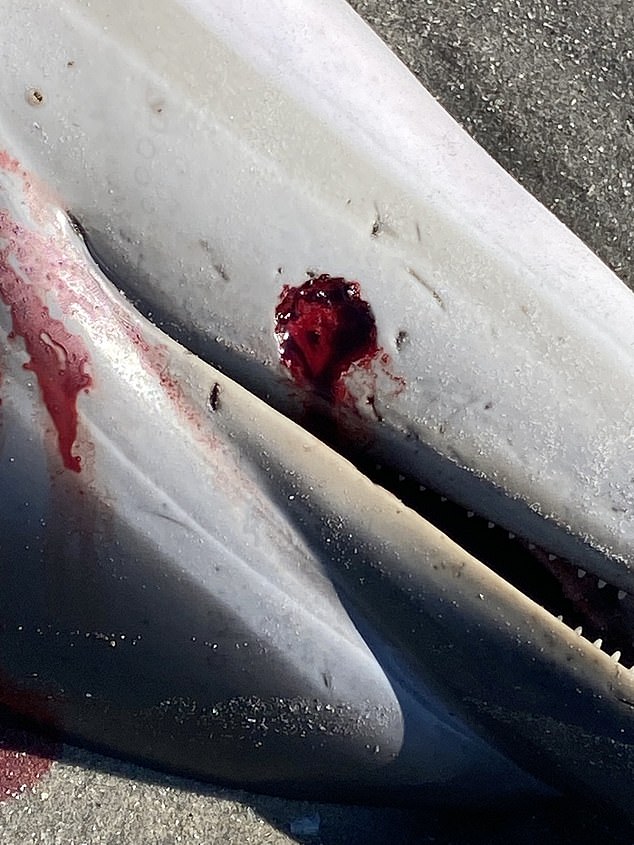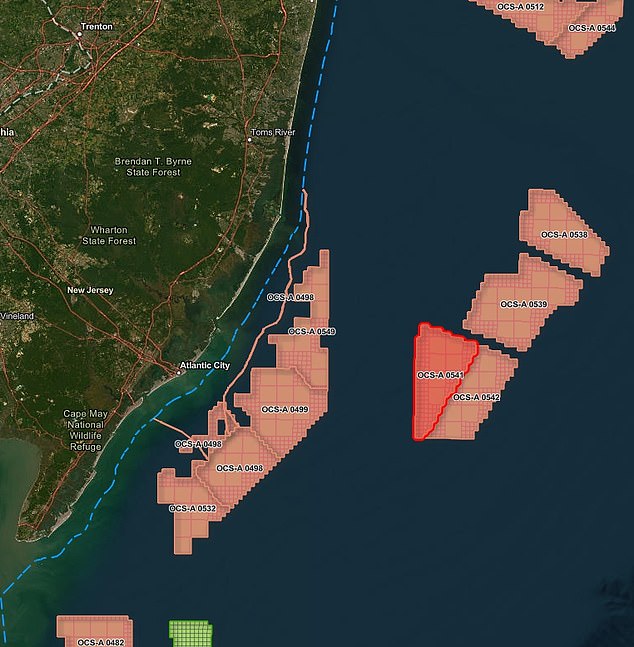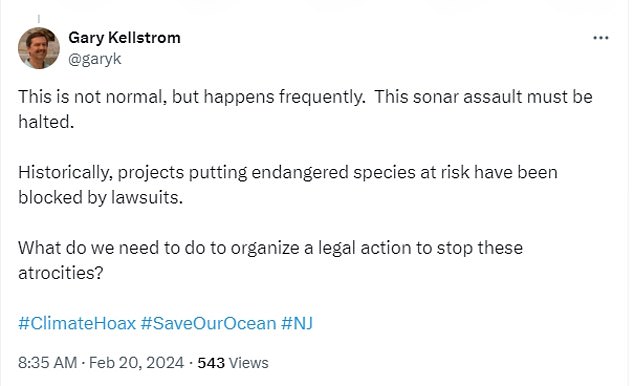Dead dolphin bleeding from eye and jaw washed up on New Jersey beach sparks investigation – as locals claim sonar blasts from offshore wind farm companies are to blame
The gruesome scene of a dead dolphin on a New Jersey beach has prompted an investigation into the cause of death.
The sea creature was spotted on February 19 lying on the sands of Avalon, bleeding from its eyes and a gaping hole along its mouth.
Locals have claimed that sonar radiation from an offshore wind company to map the seabed is the cause, as it has been suggested the technology disrupts the movements of animals and sends them into boats or onto the coast.
There is evidence that when exposed to high sonar frequencies, marine mammals swim hundreds of kilometers and change depth rapidly, which can cause bleeding from the eyes and ears.
Ship tracking data showed that a ship equipped with the technology was off the coast of New Jersey around the time of the dolphin’s death.
But experts told DailyMail.com that ‘evidence of sonar trauma is not something that would be found in an external investigation.’
The gruesome scene of a dead dolphin on a New Jersey beach has prompted an investigation into the cause of death
Bonnie Brady, executive director of the Long Island Commercial Fishing Association, told DailyMail.com that the sea creature was a short-beaked dolphin, which can be found along the continental slope in waters between 200 and 2,000 meters deep.
She noted that it is very rare for this type of dolphin to be found close to the beach.
Jamie Steiert, an Avalon resident, spotted the dead dolphin on the beach.
“NJ wildlife officer picked it up while I was there and said he was meeting with the Marine Mammal Stranding Center,” Steiert told DailyMail.com.
‘I hear they are already saying that the dolphin has been captured. We have consistently asked to prove that there is no hearing damage, but we are always left out.’
The only way to determine if a marine animal has died as a result of sonar is to perform a necropsy and analyze the ear bone for damage.

The sea creature was spotted on February 19 lying on the sands of Avalon, bleeding from its eyes and a gaping hole along its mouth.

Locals have claimed that sonar radiation from an offshore wind company to map the seabed is to blame, as it has been suggested the technology disrupts the movements of animals and sends them into boats or onto the coast.

The Mexican HOS Browning ship was identified off the coast of New Jersey four days before the dolphin was found beached
A dolphin’s ears are in the area of the lower jaw, but it is unclear whether the hole is exactly where it is located.
Steiert said the eye appeared to be missing, but the blood flowing from the hole was fresh.
‘I was especially curious about the bleeding area near the lower jaw. I wonder if it wasn’t already bleeding when it washed up and maybe something was trying to wipe it away,” Steiert said.
‘I I can tell you that when I got to the beach at 75th Street, there was no one around except a police officer who was in the car…and there was no sign of any seagulls or other birds in the area.”
Justin Viezbicke, the National Oceanic and Atmospheric Administration’s stranding coordinator, told DailyMail.com: ‘When carcasses are floating around or sitting on the beach, they are usually fed by birds and the round round hole you see, as well as the bloody eye hole. is probably the result of a bird eating the eye and pecking the lower jaw.’
The images of the dolphin were shared online and caught the attention of many New Jerseyans, with one posting on
Gary Kellstrom also shared, “This is not normal, but it happens often. This sonar attack must be stopped.
“Historically, projects that endanger endangered species have been blocked by lawsuits. What should we do to take legal action to stop these atrocities?”
The Mexican HOS Browning ship was identified four days before the dolphin was found beached off the coast of New Jersey.
HOS collaborates with Fugro, a Dutch company that provides geotechnical, surveying and geoscientific services.

US Department of Homeland Security documents also state: ‘HOS Browning, call sign XCBK8, will conduct geotechnical survey operations, utilizing a mobilized vibratory coring system

“The operations will take place within the Lease 0541 area and have been ongoing since 2022 and will continue until approximately June 30, 2024,” according to documents on the investigation. Lease 0541 is located 44 kilometers offshore and covers 79,351 hectares of water.

The images of the dolphin were shared online and caught the attention of many New Jerseyans
Fugro is conducting integrated site characterization services for Atlantic Shores Offshore Wind for the third year, using HOS to survey the ocean floor.
“They’re doing geophysical vibracoring, which is different sonars, some of which are seismic in nature,” Brady said.
Department of Homeland Security documents also state: ‘HOS Browning, call sign XCBK8, will conduct geotechnical survey operations, utilizing a mobilized vibratory coring system.
“The operations will take place in the Lease 0541 area and have been ongoing since 2022 and will continue until approximately June 30, 2024.”
Lease 0541 is located 44 kilometers offshore and covers 79,351 hectares of water.
The site is east of Atlantic City, just 36 miles (58 kilometers) from Avalon, where the dolphin was found on the beach.
However, it is unclear whether the sonar explosion affected the dolphin in any way.
